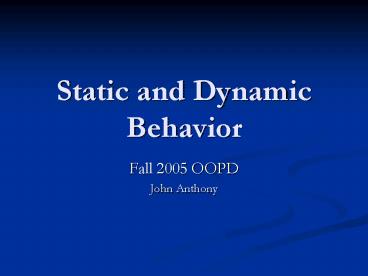Static and Dynamic Behavior - PowerPoint PPT Presentation
1 / 11
Title:
Static and Dynamic Behavior
Description:
Static almost always means fixed or bound at compile time, and cannot thereafter ... The variable is just a name. ... Animal pet = new Dog; pet.bark(); Reverse ... – PowerPoint PPT presentation
Number of Views:39
Avg rating:3.0/5.0
Title: Static and Dynamic Behavior
1
Static and Dynamic Behavior
- Fall 2005 OOPD
- John Anthony
2
Topics
- Static vs. Dynamic Typing
- Static Classes vs. Dynamic Classes
- Static vs. dynamic method Binding
Lets forget about inheritance and polymorphism
for a few moments.
3
Static vs. Dynamic
- Static almost always means fixed or bound at
compile time, and cannot thereafter be changed. - (consider OO without polymorphism)
- Dynamic almost always means not fixed or bound
until run time, and therefore can change during
the course of execution - (consider every variable as a polymorphic
variable)
4
Static vs. Dynamic Typing
- Statically Typed variables have a declared type
which is fixed at compile time.(consider Java) - Dynamically Typed types are associated with the
values only. The variable is just a name. - The variable can hold different types during the
course of execution. (consider Smalltalk)
5
Benefits and Drawbacks
- Static and Dynamically typed languages have
existed as long as there have been programming
languages. Arguments for and against - Static typing allows better error detection, more
work at compile time and hence faster execution
time. - Dynamic typing allows greater flexibility, easier
to write (for example, no declaration
statements). - Both arguments have some validity, and hence both
types of languages will continue to exist in the
future.
6
Remember the polymorphic variable???
- A variable (or reference) that can be attached to
more than one type of object.
TeamMember member new TeamMember()
polymorphic variable
InnovationLabArchitect architect new
InnovationLabArchitect ()
non polymorphic variable
7
Static Class vs. Dynamic Class
- In a statically typed language we say the class
of the declaration is the static class. The
static class is fixed at compile time and never
changes. - The dynamic class of a variable is the class
associated with the value it currently holds.
The dynamic class can change during the course of
execution.
8
Remember
Dynamic class
Static class
9
Importance of Static Class
- In a statically typed object-oriented language,
the legality of a message is determined at
compile time, based on the static class.not the
current dynamic receiver.
class Animal class Dog extends Animal
void bark() System.out.println("woof")
// will generate error since mammals don't
speakalthough //the value Dog could respond to
the message. Animal pet new Dog pet.bark()
10
Reverse Polymorphism
- Polymorphism says we can assign a value from a
child class to an instance of the parent class,
but can this assignment then be reversed? - There are two specific problems associated with
the question of reverse polymorphism. - The problem of identity - can I tell if a value
declared as an instance of a parent class
actually holds a value from a subclass.
(instanceof in Java) - The task of assignment - can I then assign the
value from the parent class to a variable
declared as the subclass. (casting)
11
Static vs. Dynamic Method Binding
- Should the binding of a message be determined by
the static class of a variable or the dynamic
class of the value? - Most OO languages use the static class to
determine the legality of the message (compile
time check). - While the correct (method) implementation is
determined by the dynamic class (run time).































